Sociology 2 Essay: Body Imaging Contrasts, Mass Society, and Influence
VerifiedAdded on 2022/08/18
|5
|1123
|11
Essay
AI Summary
This sociology essay examines the concept of body imaging contrasts, where individuals' self-perceptions may differ significantly from reality, influenced by societal factors. It explores conflicts in research, highlighting gender differences in body image concerns and the impact of mass society theories on human behavior. The essay delves into influence theory, emphasizing the importance of understanding the impact of work, and discusses how propaganda in mass culture shapes perceptions through media. It also touches upon persuasion by media and advocacy, illustrating how societal needs and public domain views influence actions. The conclusion emphasizes the role of individual perspectives and mindsets, shaped by mass society strategies and theories, in determining body image. The essay references multiple sources to support its claims.
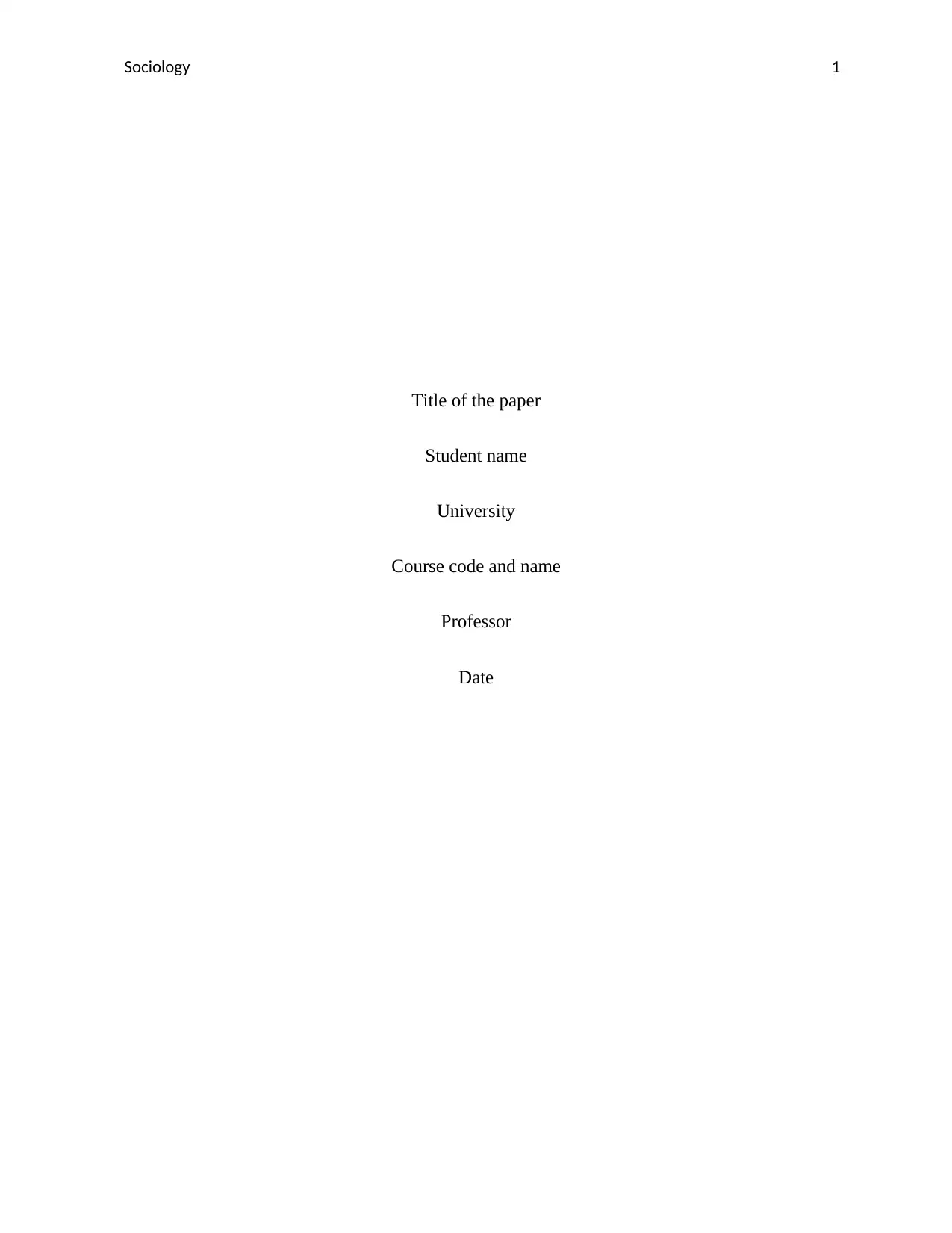
Sociology 1
Title of the paper
Student name
University
Course code and name
Professor
Date
Title of the paper
Student name
University
Course code and name
Professor
Date
Paraphrase This Document
Need a fresh take? Get an instant paraphrase of this document with our AI Paraphraser
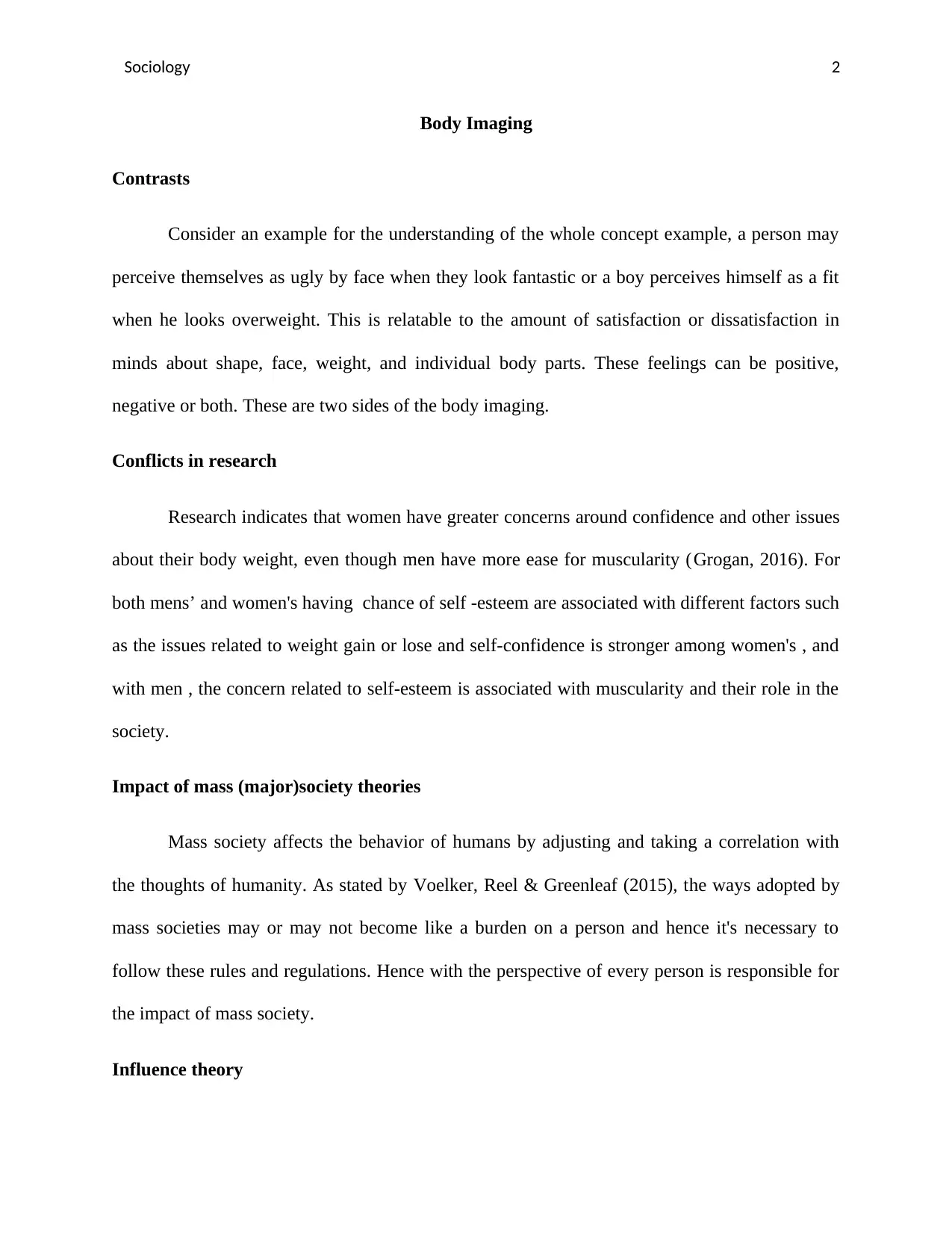
Sociology 2
Body Imaging
Contrasts
Consider an example for the understanding of the whole concept example, a person may
perceive themselves as ugly by face when they look fantastic or a boy perceives himself as a fit
when he looks overweight. This is relatable to the amount of satisfaction or dissatisfaction in
minds about shape, face, weight, and individual body parts. These feelings can be positive,
negative or both. These are two sides of the body imaging.
Conflicts in research
Research indicates that women have greater concerns around confidence and other issues
about their body weight, even though men have more ease for muscularity (Grogan, 2016). For
both mens’ and women's having chance of self -esteem are associated with different factors such
as the issues related to weight gain or lose and self-confidence is stronger among women's , and
with men , the concern related to self-esteem is associated with muscularity and their role in the
society.
Impact of mass (major)society theories
Mass society affects the behavior of humans by adjusting and taking a correlation with
the thoughts of humanity. As stated by Voelker, Reel & Greenleaf (2015), the ways adopted by
mass societies may or may not become like a burden on a person and hence it's necessary to
follow these rules and regulations. Hence with the perspective of every person is responsible for
the impact of mass society.
Influence theory
Body Imaging
Contrasts
Consider an example for the understanding of the whole concept example, a person may
perceive themselves as ugly by face when they look fantastic or a boy perceives himself as a fit
when he looks overweight. This is relatable to the amount of satisfaction or dissatisfaction in
minds about shape, face, weight, and individual body parts. These feelings can be positive,
negative or both. These are two sides of the body imaging.
Conflicts in research
Research indicates that women have greater concerns around confidence and other issues
about their body weight, even though men have more ease for muscularity (Grogan, 2016). For
both mens’ and women's having chance of self -esteem are associated with different factors such
as the issues related to weight gain or lose and self-confidence is stronger among women's , and
with men , the concern related to self-esteem is associated with muscularity and their role in the
society.
Impact of mass (major)society theories
Mass society affects the behavior of humans by adjusting and taking a correlation with
the thoughts of humanity. As stated by Voelker, Reel & Greenleaf (2015), the ways adopted by
mass societies may or may not become like a burden on a person and hence it's necessary to
follow these rules and regulations. Hence with the perspective of every person is responsible for
the impact of mass society.
Influence theory
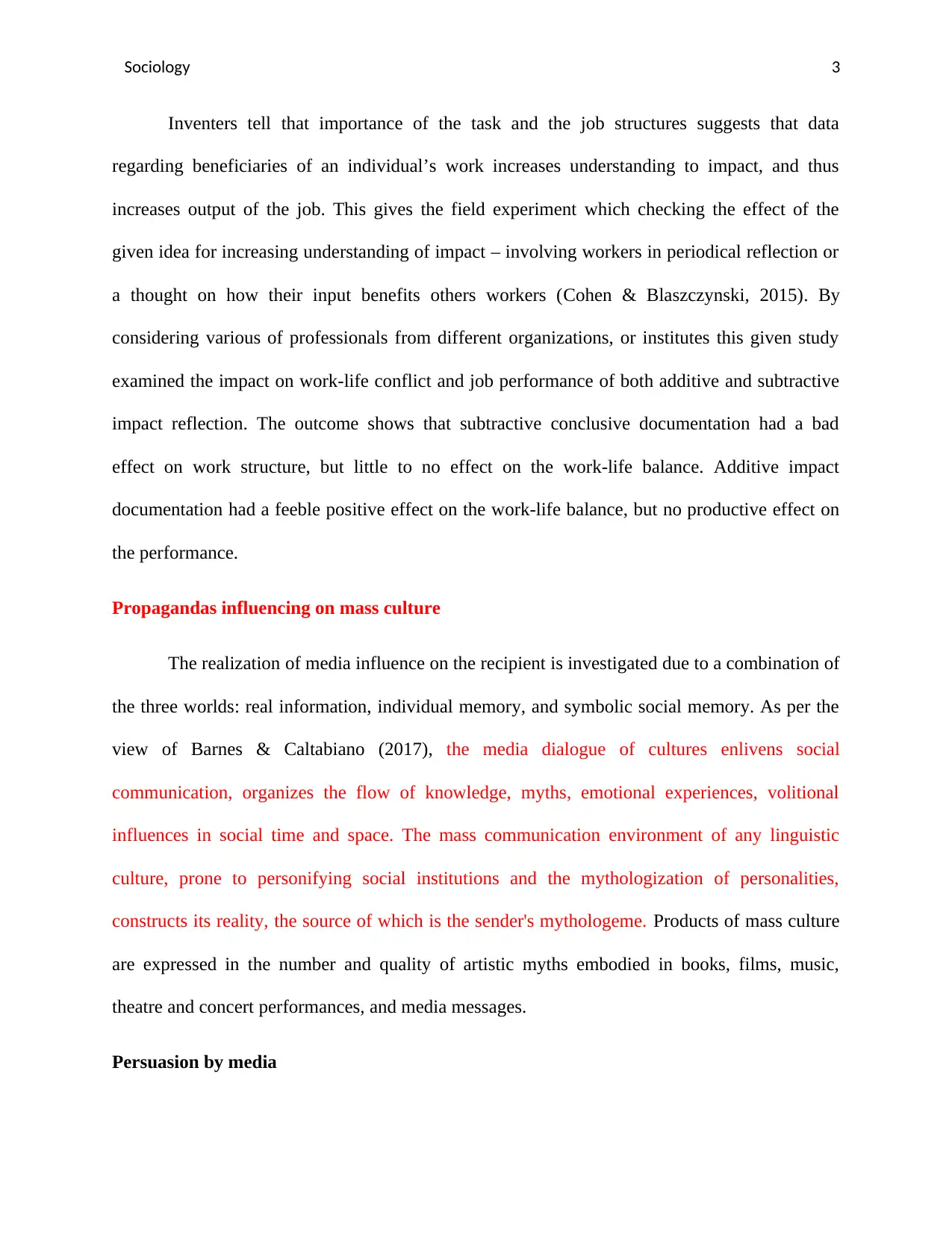
Sociology 3
Inventers tell that importance of the task and the job structures suggests that data
regarding beneficiaries of an individual’s work increases understanding to impact, and thus
increases output of the job. This gives the field experiment which checking the effect of the
given idea for increasing understanding of impact – involving workers in periodical reflection or
a thought on how their input benefits others workers (Cohen & Blaszczynski, 2015). By
considering various of professionals from different organizations, or institutes this given study
examined the impact on work-life conflict and job performance of both additive and subtractive
impact reflection. The outcome shows that subtractive conclusive documentation had a bad
effect on work structure, but little to no effect on the work-life balance. Additive impact
documentation had a feeble positive effect on the work-life balance, but no productive effect on
the performance.
Propagandas influencing on mass culture
The realization of media influence on the recipient is investigated due to a combination of
the three worlds: real information, individual memory, and symbolic social memory. As per the
view of Barnes & Caltabiano (2017), the media dialogue of cultures enlivens social
communication, organizes the flow of knowledge, myths, emotional experiences, volitional
influences in social time and space. The mass communication environment of any linguistic
culture, prone to personifying social institutions and the mythologization of personalities,
constructs its reality, the source of which is the sender's mythologeme. Products of mass culture
are expressed in the number and quality of artistic myths embodied in books, films, music,
theatre and concert performances, and media messages.
Persuasion by media
Inventers tell that importance of the task and the job structures suggests that data
regarding beneficiaries of an individual’s work increases understanding to impact, and thus
increases output of the job. This gives the field experiment which checking the effect of the
given idea for increasing understanding of impact – involving workers in periodical reflection or
a thought on how their input benefits others workers (Cohen & Blaszczynski, 2015). By
considering various of professionals from different organizations, or institutes this given study
examined the impact on work-life conflict and job performance of both additive and subtractive
impact reflection. The outcome shows that subtractive conclusive documentation had a bad
effect on work structure, but little to no effect on the work-life balance. Additive impact
documentation had a feeble positive effect on the work-life balance, but no productive effect on
the performance.
Propagandas influencing on mass culture
The realization of media influence on the recipient is investigated due to a combination of
the three worlds: real information, individual memory, and symbolic social memory. As per the
view of Barnes & Caltabiano (2017), the media dialogue of cultures enlivens social
communication, organizes the flow of knowledge, myths, emotional experiences, volitional
influences in social time and space. The mass communication environment of any linguistic
culture, prone to personifying social institutions and the mythologization of personalities,
constructs its reality, the source of which is the sender's mythologeme. Products of mass culture
are expressed in the number and quality of artistic myths embodied in books, films, music,
theatre and concert performances, and media messages.
Persuasion by media
⊘ This is a preview!⊘
Do you want full access?
Subscribe today to unlock all pages.

Trusted by 1+ million students worldwide
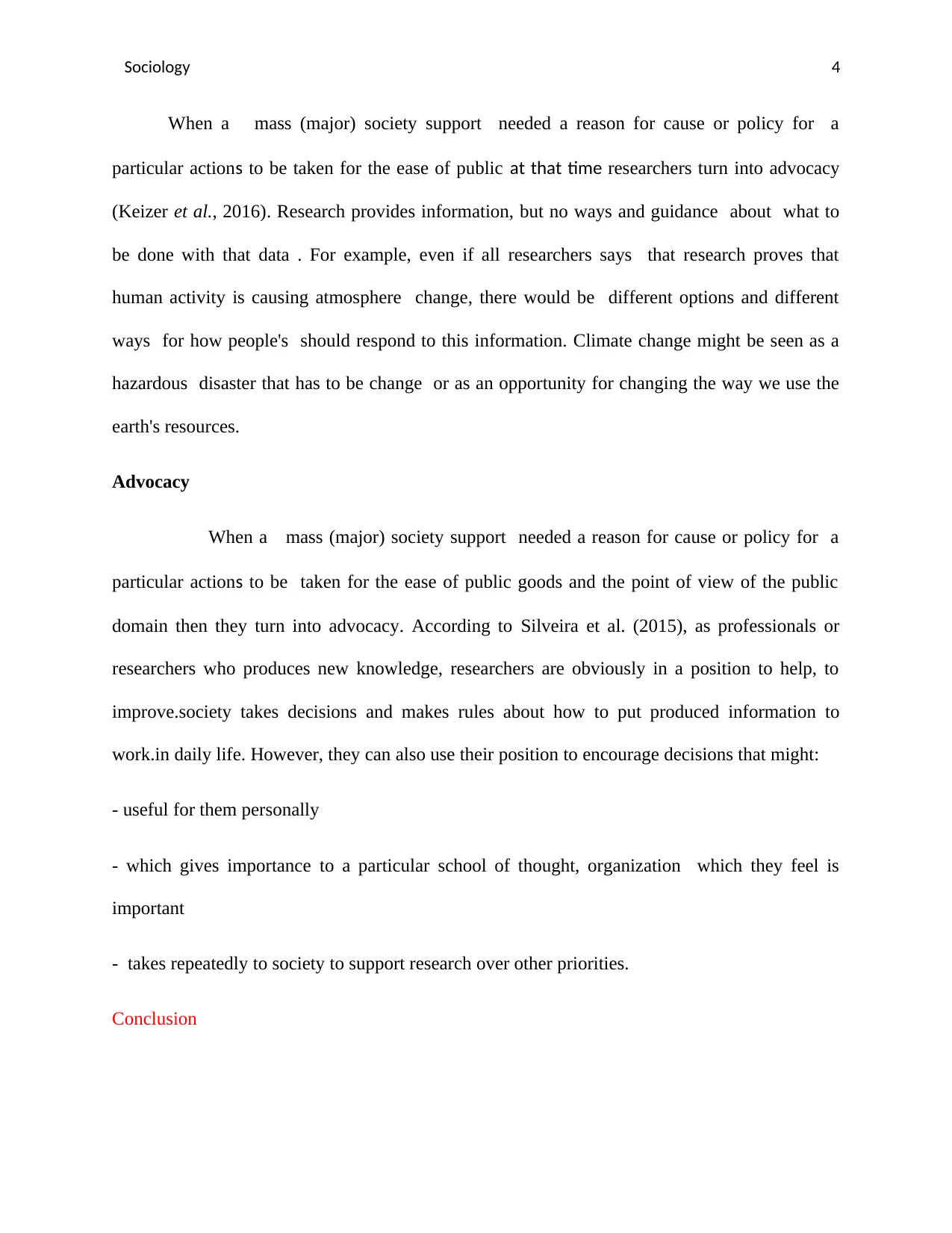
Sociology 4
When a mass (major) society support needed a reason for cause or policy for a
particular actions to be taken for the ease of public at that time researchers turn into advocacy
(Keizer et al., 2016). Research provides information, but no ways and guidance about what to
be done with that data . For example, even if all researchers says that research proves that
human activity is causing atmosphere change, there would be different options and different
ways for how people's should respond to this information. Climate change might be seen as a
hazardous disaster that has to be change or as an opportunity for changing the way we use the
earth's resources.
Advocacy
When a mass (major) society support needed a reason for cause or policy for a
particular actions to be taken for the ease of public goods and the point of view of the public
domain then they turn into advocacy. According to Silveira et al. (2015), as professionals or
researchers who produces new knowledge, researchers are obviously in a position to help, to
improve.society takes decisions and makes rules about how to put produced information to
work.in daily life. However, they can also use their position to encourage decisions that might:
- useful for them personally
- which gives importance to a particular school of thought, organization which they feel is
important
- takes repeatedly to society to support research over other priorities.
Conclusion
When a mass (major) society support needed a reason for cause or policy for a
particular actions to be taken for the ease of public at that time researchers turn into advocacy
(Keizer et al., 2016). Research provides information, but no ways and guidance about what to
be done with that data . For example, even if all researchers says that research proves that
human activity is causing atmosphere change, there would be different options and different
ways for how people's should respond to this information. Climate change might be seen as a
hazardous disaster that has to be change or as an opportunity for changing the way we use the
earth's resources.
Advocacy
When a mass (major) society support needed a reason for cause or policy for a
particular actions to be taken for the ease of public goods and the point of view of the public
domain then they turn into advocacy. According to Silveira et al. (2015), as professionals or
researchers who produces new knowledge, researchers are obviously in a position to help, to
improve.society takes decisions and makes rules about how to put produced information to
work.in daily life. However, they can also use their position to encourage decisions that might:
- useful for them personally
- which gives importance to a particular school of thought, organization which they feel is
important
- takes repeatedly to society to support research over other priorities.
Conclusion
Paraphrase This Document
Need a fresh take? Get an instant paraphrase of this document with our AI Paraphraser
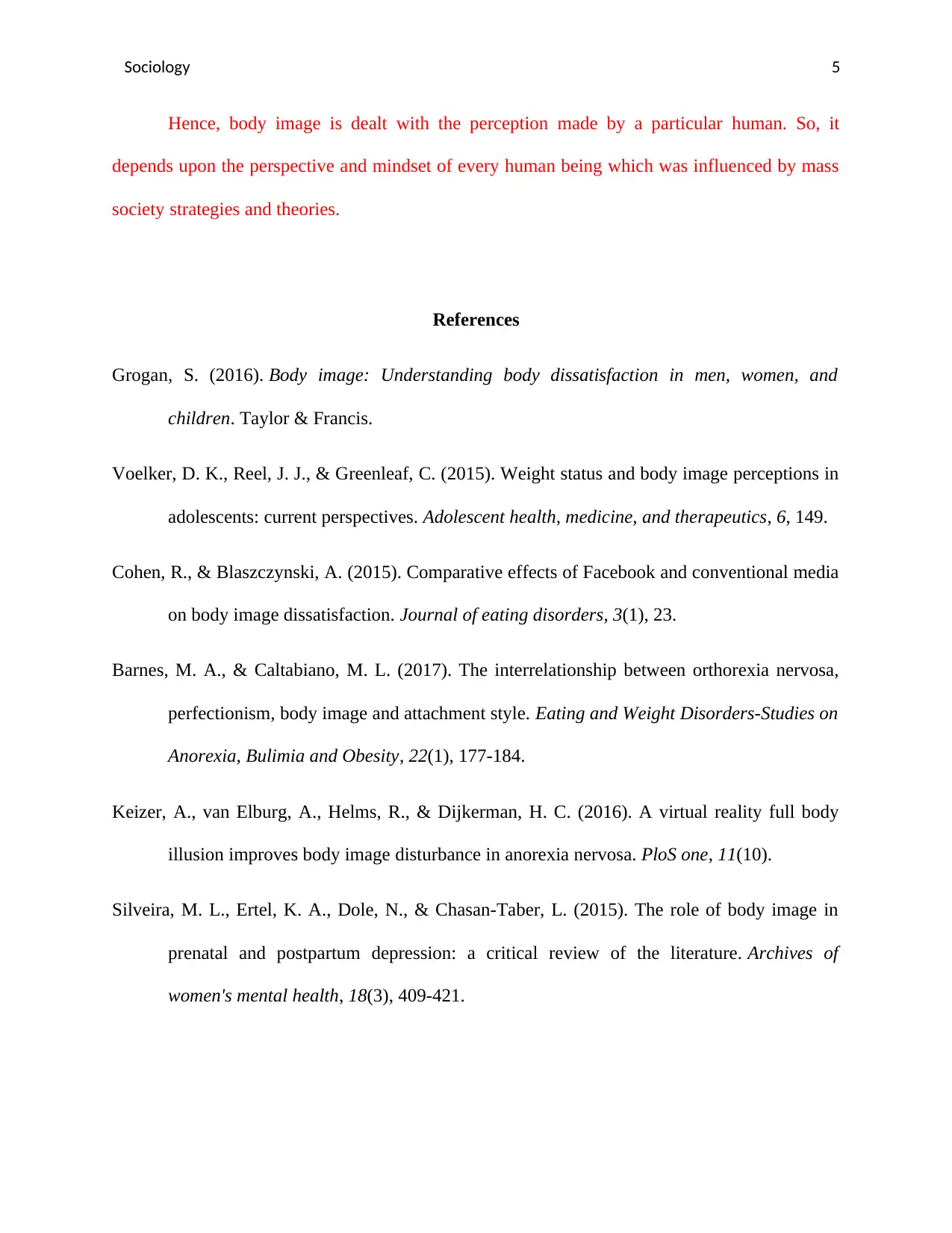
Sociology 5
Hence, body image is dealt with the perception made by a particular human. So, it
depends upon the perspective and mindset of every human being which was influenced by mass
society strategies and theories.
References
Grogan, S. (2016). Body image: Understanding body dissatisfaction in men, women, and
children. Taylor & Francis.
Voelker, D. K., Reel, J. J., & Greenleaf, C. (2015). Weight status and body image perceptions in
adolescents: current perspectives. Adolescent health, medicine, and therapeutics, 6, 149.
Cohen, R., & Blaszczynski, A. (2015). Comparative effects of Facebook and conventional media
on body image dissatisfaction. Journal of eating disorders, 3(1), 23.
Barnes, M. A., & Caltabiano, M. L. (2017). The interrelationship between orthorexia nervosa,
perfectionism, body image and attachment style. Eating and Weight Disorders-Studies on
Anorexia, Bulimia and Obesity, 22(1), 177-184.
Keizer, A., van Elburg, A., Helms, R., & Dijkerman, H. C. (2016). A virtual reality full body
illusion improves body image disturbance in anorexia nervosa. PloS one, 11(10).
Silveira, M. L., Ertel, K. A., Dole, N., & Chasan-Taber, L. (2015). The role of body image in
prenatal and postpartum depression: a critical review of the literature. Archives of
women's mental health, 18(3), 409-421.
Hence, body image is dealt with the perception made by a particular human. So, it
depends upon the perspective and mindset of every human being which was influenced by mass
society strategies and theories.
References
Grogan, S. (2016). Body image: Understanding body dissatisfaction in men, women, and
children. Taylor & Francis.
Voelker, D. K., Reel, J. J., & Greenleaf, C. (2015). Weight status and body image perceptions in
adolescents: current perspectives. Adolescent health, medicine, and therapeutics, 6, 149.
Cohen, R., & Blaszczynski, A. (2015). Comparative effects of Facebook and conventional media
on body image dissatisfaction. Journal of eating disorders, 3(1), 23.
Barnes, M. A., & Caltabiano, M. L. (2017). The interrelationship between orthorexia nervosa,
perfectionism, body image and attachment style. Eating and Weight Disorders-Studies on
Anorexia, Bulimia and Obesity, 22(1), 177-184.
Keizer, A., van Elburg, A., Helms, R., & Dijkerman, H. C. (2016). A virtual reality full body
illusion improves body image disturbance in anorexia nervosa. PloS one, 11(10).
Silveira, M. L., Ertel, K. A., Dole, N., & Chasan-Taber, L. (2015). The role of body image in
prenatal and postpartum depression: a critical review of the literature. Archives of
women's mental health, 18(3), 409-421.
1 out of 5
Related Documents
Your All-in-One AI-Powered Toolkit for Academic Success.
+13062052269
info@desklib.com
Available 24*7 on WhatsApp / Email
![[object Object]](/_next/static/media/star-bottom.7253800d.svg)
Unlock your academic potential
Copyright © 2020–2025 A2Z Services. All Rights Reserved. Developed and managed by ZUCOL.




